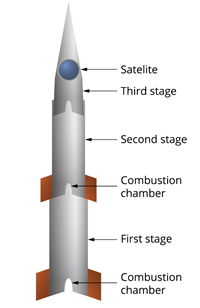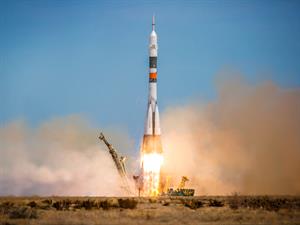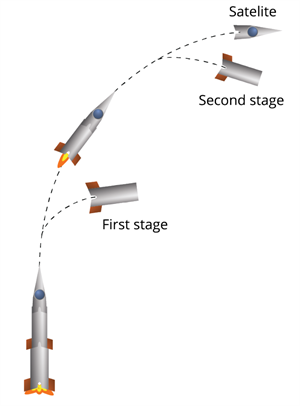PDF chapter test TRY NOW
Rocket balloon activity:
Procedure:
- A big rubber balloon is taken and inflated.
- The neck of the balloon is tied using a thread.
- The straw is then fixed on the surface of the balloon using tape.
- A thread is taken and passed through the straw by holding one end of the thread in hand.
- Now, both the ends of the thread are fixed with some distance between the walls.
- The thread tied to the neck of the balloon is now removed, thus allowing the air to escape through the mouth of the balloon.

Thrust acting on the balloon
Inference:
When the air escapes out from the balloon at one end, straw moves to the opposite direction along with the balloon. The balloon's action is similar to the movement of rocket.
When the air escapes out from the balloon at one end, straw moves to the opposite direction along with the balloon. The balloon's action is similar to the movement of rocket.
Launching of a rocket:
Initially, the rockets are held down by clamps on the launching pad before being launched into space. At the very top of the rocket, manned or unmanned satellites are kept.

Parts of a rocket
When the rocket's fuel is burnt, an upward thrust is generated. After some time, there will be a stage where the upward thrust will eventually exceed the satellite's weight. The clamp will then be released by remote control at that stage, and the rocket will be launched upwards.

Rocket launching
According to Newton's third law, any action has an equal and opposite reaction. Hence, the rocket would fly upwards as the gas is released downward.
Positioning the satellite:
A satellite must be lifted to the appropriate height and given the correct speed and direction by the launching rocket in order to be placed in a specific orbit.If the rocket is launched at a high velocity near the earth's surface, it will burn up due to air friction. Furthermore, such high speeds cannot be achieved by a single rocket. As a result, multistage rockets are employed.

Stages of rocket
At first, the rocket rises vertically and then it is tilted at an angle by a guidance mechanism to get through the lower dense part of the atmosphere.
